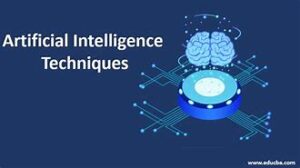Key Concepts and Techniques in AI
1. Machine Learning
o. Supervised Learning
- Definition: A type of machine learning where the model is trained on a labeled dataset, meaning the input data is paired with the correct output. The model learns to map inputs to outputs based on this data.
- Applications: Spam detection, image classification, and predictive modeling in finance.
o. Unsupervised Learning
- Definition: In this approach, the model is trained on data without labeled outputs. The goal is to identify hidden patterns or structures within the data.
- Applications: Customer segmentation, anomaly detection, and recommendation systems.
o. Reinforcement Learning
- Definition: A type of machine learning where an agent learns to make decisions by taking actions in an environment to maximize cumulative rewards. The agent learns through trial and error.
- Applications: Robotics, game playing (e.g., AlphaGo), and autonomous vehicles.
2. Deep Learning
o. Neural Networks
- Definition: A fundamental building block of deep learning, neural networks consist of layers of interconnected nodes (neurons) that process and learn from data to make decisions or predictions.
- Applications: Image and speech recognition, natural language processing.
o. Convolutional Neural Networks (CNNs)
- Definition: A specialized type of neural network designed to process structured grid data like images. CNNs are particularly effective in identifying spatial hierarchies in images through layers of convolutional filters.
- Applications: Image and video recognition, medical image analysis, and object detection.
o. Recurrent Neural Networks (RNNs)
- Definition: RNNs are neural networks designed to recognize patterns in sequences of data, such as time series or natural language. They maintain a memory of previous inputs to inform future predictions.
- Applications: Language modeling, machine translation, and time-series forecasting.
3. Natural Language Processing (NLP)
o. Language Models
- Definition: Language models are AI models that understand and generate human language. They predict the likelihood of a sequence of words, enabling tasks such as text completion, translation, and dialogue generation.
- Applications: Chatbots, language translation, and sentiment analysis.
o. Text Analysis and Generation
- Definition: NLP techniques that involve analyzing and interpreting text data, as well as generating new text that is coherent and contextually relevant.
- Applications: Content generation, summarization, and automated report writing.
4. Computer Vision
o. Image Recognition
- Definition: A technique that enables machines to interpret and classify images by identifying patterns, objects, and features within them.
- Applications: Facial recognition, medical imaging, and security systems.
o. Object Detection
- Definition: An advanced computer vision technique that involves identifying and locating objects within an image or video, often by drawing bounding boxes around them.
- Applications: Autonomous vehicles, video surveillance, and augmented reality.
5. Robotics and Automation
o. AI in Robotics
- Definition: The integration of AI with robotics to enable machines to perform tasks autonomously, adapt to new situations, and interact with their environment in intelligent ways.
- Applications: Industrial automation, surgical robots, and service robots.
o. Autonomous Systems
- Definition: Systems that operate independently, making decisions and taking actions without human intervention, often using AI to navigate and perform complex tasks.
- Applications: Drones, autonomous vehicles, and smart manufacturing systems.
Read more on Introduction to Artificial Intelligence



